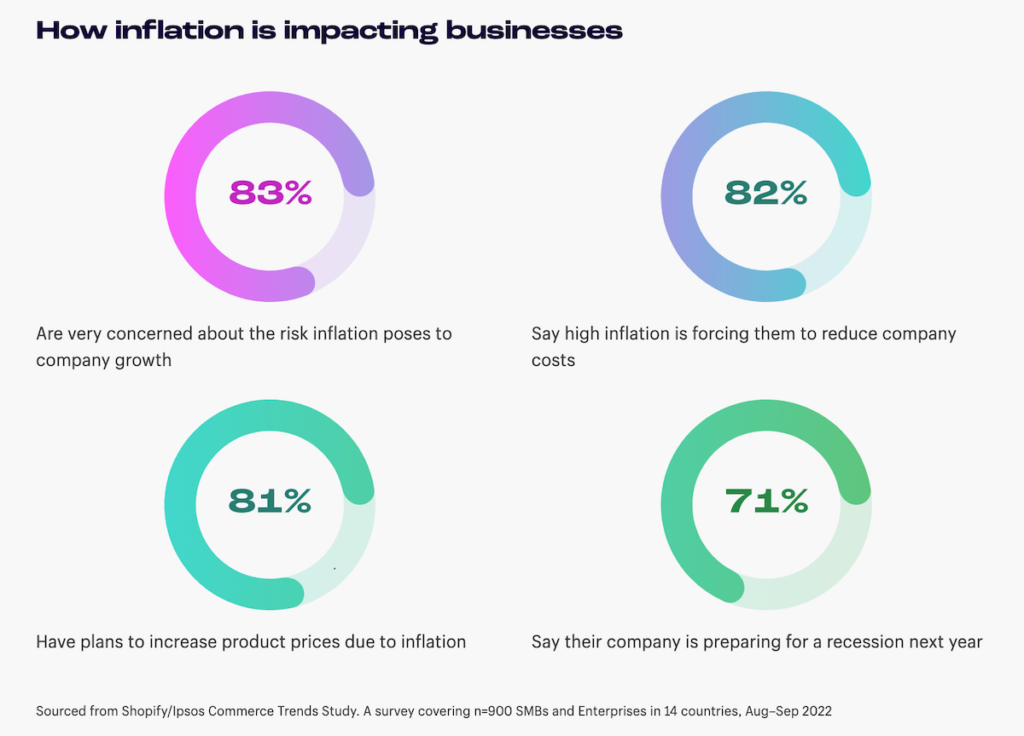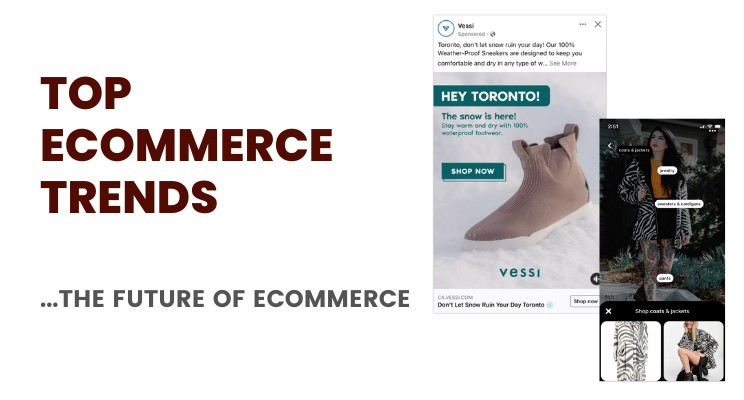Each of these top eCommerce trends has hidden layers of opportunities for businesses that dare to adapt and even thrive. Read on 👇
Businesses and brands are still grappling with whatever was thrown at them. After lockdowns, black swan events, restrictions, supply chain fiascos, and overall uncertainty, businesses figured out the need for creativity, innovation, super management, flexibility to push products (or plans, or product bundles).
The key: To be agile. To respond smart. To ensure survival. To adapt to change (the only constant)
Uncertainty or not, businesses continue to stay resilient. More than U.S $27 Trillion sales worldwide and more 64% of global businesses are still recovering from the pandemic (still……).
eCommerce and online shopping saw an uptrend with 77% year over year increase just a few months into the pandemic.
eCommerce sales are projected to reach more than U.S $31 Trillion in 2025 (and it’s going to be a slow climb at that) — thanks to inflation, continuing geo-political tensions, the still looming pandemic, recession, and more.

Here are some of the top eCommerce trends you can swear by, get cues from, realign your eCommerce marketing strategy, and more:
Email Marketing For eCommerce Is Da Boss
According to Drip, here are some eCommerce email marketing trends that shook up all of 2022.
- More than 7.8 billion emails were sent using Drip alone. Add in other email service providers such as ConvertKit, Moosend, MailerLite, Klaviyo, Mailchimp, and others and pump up that number further.
- “Abandoned Cart” emails were the top performing email marketing automation workflow type. These “Abandoned cart emails” also made up for 62% of the top performing eCommerce email automations.
- The top industries (among Drip customers) were Apparel and fashion; food and beverage; health and fitness; automotive and vehicles; and sporting and outdoors.
- More than 174 million emails were sent (11% increase from last year) during BFCM. Drip customers saw an average 12% increase in sales (compared to pre-pandemic levels).
- Drip processed a whopping 1.38 billion events.
Even with email marketing (as one channel, amongst others), businesses that prioritized brands that customers love and audiences who’ll swear by these brands outlasted those that don’t.
Email marketing campaigns — segmented, personalized, sharp, and relevant — that nurtured existing customer relationships outperformed every other type of email (such as one-off promotional emails or broadcasts).
Further, customer newsletters — along with post-purchase emails — were amongst the other top performing email campaigns.
Read:
6 Retail Marketing Examples to Inspire Your Email Marketing
Buy Now Pay Later & Payment Flexibility
Making various payment methods, payment options is critical for eCommerce (and this is still a after thought for many brands).
The usual payment options are Paypal, Stripe, Credit Cards, Debit Cards, and others. Depending on geography and target markets, there are several other payment options that kick in.
Chinese eCommerce brands (and consumers) use wallets such as AliPay, WeChat, Union Pay, and others for payments. India has had stupendous shift in consumer payments with UPI payments, Wallets (Paytm, Amazon Pay, Phone Pe, Google Pay, and others) on top of regular credit card and debit card payments.
Along with the surging popularity of Buy Now Pay Later options and shifting changes in the payments space, eCommerce merchants now also have several fantastic options such as Shop Pay for Shopify merchants which allows customers to Buy Now Pay Later, manage payments, split payments, pay in instalments, and more.
Read:
Bet on These 6 eCommerce Payment Trends
Collaborations Are Critical
With increasing ad costs and rising cost of acquisition of customers worldwide, eCommerce merchants are fast looking for ways to maximize investments. One of the better things to come along now are the ever-increasing number of content creators, bloggers, and influencers (across content formats).
Each of these influencers have audiences that they built over time: audiences that love these influencers, consume their content, and trust recommendations.
According to these Influencer marketing Statistics, more than 48% of the entire Internet population is active on social media platforms. More than 38% of social media users trust branded social media content and more than 60% trust social media influencer recommendations.
You could directly work with influencers to start building relationships and deals going for you. Shopify merchants also have tools like Shopify Collabs which comes with a huge database of influencers you could find in a single place. Shopify Collabs also has features such as gift tracking, affiliate links or codes, commissions management, and performance tracking built in.
If you are not on Shopify, you could also find several ambitious creators, influencers, affiliate partners, and many others through networks such as ShareaSale, Tapfiliate, and PartnerStack. Or, you could run your own partner programs by using some of the best affiliate marketing software.
Read:
30+ Influencer Marketing Statistics You Should Know
13 Leading Influencer Marketing Platforms
Social Commerce Is The New Commerce
eCommerce commands a major share of sales worldwide (even though overall sales are slow). According to Marketing Dive, 9 in 10 people buy from brands they follow on social media.
Social commerce is a paradigm shift in how consumers now interact with brands.
None of those sales are mere transactions (click, swipe, and forget? No way).
Social media for commerce (or social commerce in short), generated US $475 billion in 2020. This number is expected to reach US $3.3 Trillion by 2028, according to Statista.
Want to win with social commerce? It’s all about trust
Just as Nike does it, Starting from everything about how your eCommerce store loads, how it looks like, how it feels, and how fast it is and going all the way to spectacular eCommerce support — social commerce is all about making it all a seamless experience for shoppers.
Smooth and fast checkout, frictionless payments, social proof, social engagements, and mobile commerce checkout flows while staying actively engaged on popular social media platforms is key for eCommerce growth.
Read:
What Is Social Commerce? Tips, Tools, and Trends
Social Commerce: The Future of How Consumers Interact With Brands
Customer Retention Is Gold
It takes a lot more money to acquire a customer than it’d to keep one. You know that, but you don’t much about it.
I’ve written about eCommerce retention strategies earlier. While consumers are open to try new brands (or even different products from the same brand), a sense of comfort and inertia kicks in allowing for long retention periods (as long as you take care of what you need to)
Consider GAP – the brand: More than 70% of Gap’s customers prefer to buy “furniture” from Gap (if at all). In a Bain and Company Study, it was revealed that for the “apparel” category, the average repeat customer spent 67% more in the 31st to 36th month of shopping compared to their relationship in the first 6 months or so.
Customer retention (keeping customers for long) helps you find a better way to sell products or services to existing customers and boost your brand and cause a higher average order value.
Adopt classic customer retention strategies now:
- Use customer accounts (let them create accounts) but also allow for guest checkout.
- Introduce loyalty programs or reward programs.
- Launch eCommerce subscription layers on top of existing products and services or as independent subscription products. See how some brands run subscriptions.
- Send engaging emails. Use the likes of Mailerlite, Moosend, Drip, and Klaviyo. ConvertKit for digital products, blogging, online publications, and other businesses.
- Start a referral program. Here’s a list of referral software you could consider.
- Offer personalized shopping experiences and delight customers.
- Use free shipping as a standard. Some eCommerce platforms have full-fledged shipping programs.
Customer Service Is Profitable
More than 90% of customers reveal that “customer service” is a key deciding factor when it comes making purchase decisions.
Yet, it’s one of things eCommerce brands and businesses of all sizes just ignore.
Spectacular customer service is a direct path to at least more than 300% higher profitability [http://gorgias.com/guides/cx-growth-playbook].
Brands make billions, just by being nice, responsive, thoughtful, and by treating customers as humans. It’s a billion dollar profit centre you probably ignore.
This is one of things that’s easy to overlook, and even easier to “not do” given the other glamorous things such as growth hacks and eCommerce platforms.
- eCommerce support best practices are there for a reason: they just work.
- Use customer support tools and customer service suites that work well with your business.
- Avoid vanity metrics (no matter how tempting it is). Here are the exact customer support KPIs and metrics you should measure.
- At the very least, you should employ live chat or chat bots (with necessary human intervention). Learn the difference between live chats and chat bots.
Read:
15+ eCommerce Support Best Practices To Help You Level Up
8 Customer Service Challenges Harming Your Revenue + Solutions
What are some of the top eCommerce trends you foresee? How do you think eCommerce will shape up in the future?

